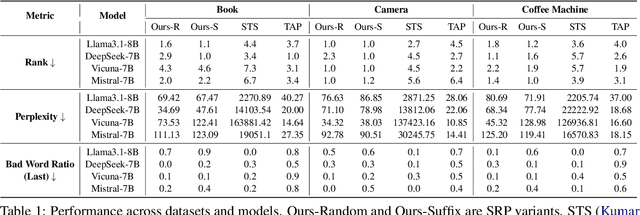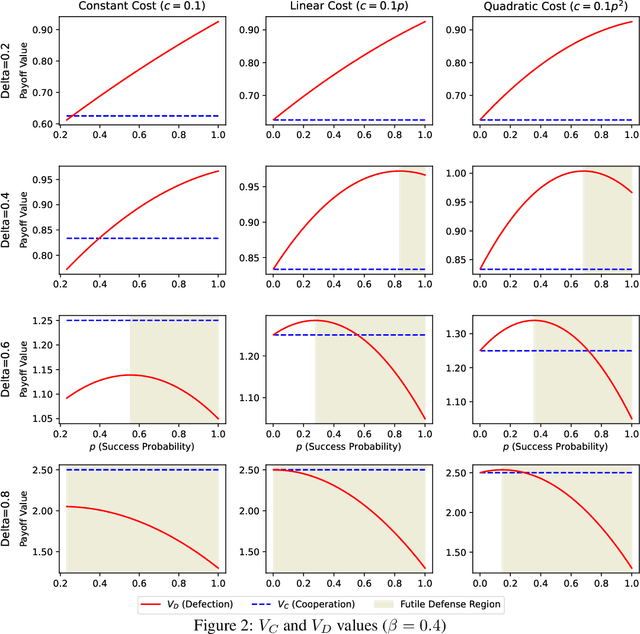Xiyang Hu
Ben
A Personalized Conversational Benchmark: Towards Simulating Personalized Conversations
May 20, 2025Abstract:We present PersonaConvBench, a large-scale benchmark for evaluating personalized reasoning and generation in multi-turn conversations with large language models (LLMs). Unlike existing work that focuses on either personalization or conversational structure in isolation, PersonaConvBench integrates both, offering three core tasks: sentence classification, impact regression, and user-centric text generation across ten diverse Reddit-based domains. This design enables systematic analysis of how personalized conversational context shapes LLM outputs in realistic multi-user scenarios. We benchmark several commercial and open-source LLMs under a unified prompting setup and observe that incorporating personalized history yields substantial performance improvements, including a 198 percent relative gain over the best non-conversational baseline in sentiment classification. By releasing PersonaConvBench with evaluations and code, we aim to support research on LLMs that adapt to individual styles, track long-term context, and produce contextually rich, engaging responses.
AD-AGENT: A Multi-agent Framework for End-to-end Anomaly Detection
May 19, 2025Abstract:Anomaly detection (AD) is essential in areas such as fraud detection, network monitoring, and scientific research. However, the diversity of data modalities and the increasing number of specialized AD libraries pose challenges for non-expert users who lack in-depth library-specific knowledge and advanced programming skills. To tackle this, we present AD-AGENT, an LLM-driven multi-agent framework that turns natural-language instructions into fully executable AD pipelines. AD-AGENT coordinates specialized agents for intent parsing, data preparation, library and model selection, documentation mining, and iterative code generation and debugging. Using a shared short-term workspace and a long-term cache, the agents integrate popular AD libraries like PyOD, PyGOD, and TSLib into a unified workflow. Experiments demonstrate that AD-AGENT produces reliable scripts and recommends competitive models across libraries. The system is open-sourced to support further research and practical applications in AD.
Graph Synthetic Out-of-Distribution Exposure with Large Language Models
Apr 29, 2025Abstract:Out-of-distribution (OOD) detection in graphs is critical for ensuring model robustness in open-world and safety-sensitive applications. Existing approaches to graph OOD detection typically involve training an in-distribution (ID) classifier using only ID data, followed by the application of post-hoc OOD scoring techniques. Although OOD exposure - introducing auxiliary OOD samples during training - has proven to be an effective strategy for enhancing detection performance, current methods in the graph domain generally assume access to a set of real OOD nodes. This assumption, however, is often impractical due to the difficulty and cost of acquiring representative OOD samples. In this paper, we introduce GOE-LLM, a novel framework that leverages Large Language Models (LLMs) for OOD exposure in graph OOD detection without requiring real OOD nodes. GOE-LLM introduces two pipelines: (1) identifying pseudo-OOD nodes from the initially unlabeled graph using zero-shot LLM annotations, and (2) generating semantically informative synthetic OOD nodes via LLM-prompted text generation. These pseudo-OOD nodes are then used to regularize the training of the ID classifier for improved OOD awareness. We evaluate our approach across multiple benchmark datasets, showing that GOE-LLM significantly outperforms state-of-the-art graph OOD detection methods that do not use OOD exposure and achieves comparable performance to those relying on real OOD data.
StealthRank: LLM Ranking Manipulation via Stealthy Prompt Optimization
Apr 08, 2025



Abstract:The integration of large language models (LLMs) into information retrieval systems introduces new attack surfaces, particularly for adversarial ranking manipulations. We present StealthRank, a novel adversarial ranking attack that manipulates LLM-driven product recommendation systems while maintaining textual fluency and stealth. Unlike existing methods that often introduce detectable anomalies, StealthRank employs an energy-based optimization framework combined with Langevin dynamics to generate StealthRank Prompts (SRPs)-adversarial text sequences embedded within product descriptions that subtly yet effectively influence LLM ranking mechanisms. We evaluate StealthRank across multiple LLMs, demonstrating its ability to covertly boost the ranking of target products while avoiding explicit manipulation traces that can be easily detected. Our results show that StealthRank consistently outperforms state-of-the-art adversarial ranking baselines in both effectiveness and stealth, highlighting critical vulnerabilities in LLM-driven recommendation systems.
Generative AI in Transportation Planning: A Survey
Mar 10, 2025Abstract:The integration of generative artificial intelligence (GenAI) into transportation planning has the potential to revolutionize tasks such as demand forecasting, infrastructure design, policy evaluation, and traffic simulation. However, there is a critical need for a systematic framework to guide the adoption of GenAI in this interdisciplinary domain. In this survey, we, a multidisciplinary team of researchers spanning computer science and transportation engineering, present the first comprehensive framework for leveraging GenAI in transportation planning. Specifically, we introduce a new taxonomy that categorizes existing applications and methodologies into two perspectives: transportation planning tasks and computational techniques. From the transportation planning perspective, we examine the role of GenAI in automating descriptive, predictive, generative, simulation, and explainable tasks to enhance mobility systems. From the computational perspective, we detail advancements in data preparation, domain-specific fine-tuning, and inference strategies, such as retrieval-augmented generation and zero-shot learning tailored to transportation applications. Additionally, we address critical challenges, including data scarcity, explainability, bias mitigation, and the development of domain-specific evaluation frameworks that align with transportation goals like sustainability, equity, and system efficiency. This survey aims to bridge the gap between traditional transportation planning methodologies and modern AI techniques, fostering collaboration and innovation. By addressing these challenges and opportunities, we seek to inspire future research that ensures ethical, equitable, and impactful use of generative AI in transportation planning.
Secure On-Device Video OOD Detection Without Backpropagation
Mar 08, 2025Abstract:Out-of-Distribution (OOD) detection is critical for ensuring the reliability of machine learning models in safety-critical applications such as autonomous driving and medical diagnosis. While deploying personalized OOD detection directly on edge devices is desirable, it remains challenging due to large model sizes and the computational infeasibility of on-device training. Federated learning partially addresses this but still requires gradient computation and backpropagation, exceeding the capabilities of many edge devices. To overcome these challenges, we propose SecDOOD, a secure cloud-device collaboration framework for efficient on-device OOD detection without requiring device-side backpropagation. SecDOOD utilizes cloud resources for model training while ensuring user data privacy by retaining sensitive information on-device. Central to SecDOOD is a HyperNetwork-based personalized parameter generation module, which adapts cloud-trained models to device-specific distributions by dynamically generating local weight adjustments, effectively combining central and local information without local fine-tuning. Additionally, our dynamic feature sampling and encryption strategy selectively encrypts only the most informative feature channels, largely reducing encryption overhead without compromising detection performance. Extensive experiments across multiple datasets and OOD scenarios demonstrate that SecDOOD achieves performance comparable to fully fine-tuned models, enabling secure, efficient, and personalized OOD detection on resource-limited edge devices. To enhance accessibility and reproducibility, our code is publicly available at https://github.com/Dystopians/SecDOOD.
Dynamics of Adversarial Attacks on Large Language Model-Based Search Engines
Jan 01, 2025


Abstract:The increasing integration of Large Language Model (LLM) based search engines has transformed the landscape of information retrieval. However, these systems are vulnerable to adversarial attacks, especially ranking manipulation attacks, where attackers craft webpage content to manipulate the LLM's ranking and promote specific content, gaining an unfair advantage over competitors. In this paper, we study the dynamics of ranking manipulation attacks. We frame this problem as an Infinitely Repeated Prisoners' Dilemma, where multiple players strategically decide whether to cooperate or attack. We analyze the conditions under which cooperation can be sustained, identifying key factors such as attack costs, discount rates, attack success rates, and trigger strategies that influence player behavior. We identify tipping points in the system dynamics, demonstrating that cooperation is more likely to be sustained when players are forward-looking. However, from a defense perspective, we find that simply reducing attack success probabilities can, paradoxically, incentivize attacks under certain conditions. Furthermore, defensive measures to cap the upper bound of attack success rates may prove futile in some scenarios. These insights highlight the complexity of securing LLM-based systems. Our work provides a theoretical foundation and practical insights for understanding and mitigating their vulnerabilities, while emphasizing the importance of adaptive security strategies and thoughtful ecosystem design.
A Large-scale Empirical Study on Large Language Models for Election Prediction
Dec 19, 2024



Abstract:Can Large Language Models (LLMs) accurately predict election outcomes? While LLMs have demonstrated impressive performance in healthcare, legal analysis, and creative applications, their capabilities in election forecasting remain uncertain. Notably, election prediction poses unique challenges: limited voter-level data, evolving political contexts, and the complexity of modeling human behavior. In the first part of this paper, we explore and introduce a multi-step reasoning framework for election prediction, which systematically integrates demographic, ideological, and time-sensitive factors. Validated on 2016 and 2020 real-world data and extensive synthetic personas, our approach adapts to changing political landscapes, reducing bias and significantly improving predictive accuracy. We further apply our pipeline to the 2024 U.S. presidential election, illustrating its ability to generalize beyond observed historical data. Beyond enhancing accuracy, the second part of the paper provides insights into the broader implications of LLM-based election forecasting. We identify potential political biases embedded in pretrained corpora, examine how demographic patterns can become exaggerated, and suggest strategies for mitigating these issues. Together, this project, a large-scale LLM empirical study, advances the accuracy of election predictions and establishes directions for more balanced, transparent, and context-aware modeling in political science research and practice.
AD-LLM: Benchmarking Large Language Models for Anomaly Detection
Dec 15, 2024



Abstract:Anomaly detection (AD) is an important machine learning task with many real-world uses, including fraud detection, medical diagnosis, and industrial monitoring. Within natural language processing (NLP), AD helps detect issues like spam, misinformation, and unusual user activity. Although large language models (LLMs) have had a strong impact on tasks such as text generation and summarization, their potential in AD has not been studied enough. This paper introduces AD-LLM, the first benchmark that evaluates how LLMs can help with NLP anomaly detection. We examine three key tasks: (i) zero-shot detection, using LLMs' pre-trained knowledge to perform AD without tasks-specific training; (ii) data augmentation, generating synthetic data and category descriptions to improve AD models; and (iii) model selection, using LLMs to suggest unsupervised AD models. Through experiments with different datasets, we find that LLMs can work well in zero-shot AD, that carefully designed augmentation methods are useful, and that explaining model selection for specific datasets remains challenging. Based on these results, we outline six future research directions on LLMs for AD.
Political-LLM: Large Language Models in Political Science
Dec 09, 2024



Abstract:In recent years, large language models (LLMs) have been widely adopted in political science tasks such as election prediction, sentiment analysis, policy impact assessment, and misinformation detection. Meanwhile, the need to systematically understand how LLMs can further revolutionize the field also becomes urgent. In this work, we--a multidisciplinary team of researchers spanning computer science and political science--present the first principled framework termed Political-LLM to advance the comprehensive understanding of integrating LLMs into computational political science. Specifically, we first introduce a fundamental taxonomy classifying the existing explorations into two perspectives: political science and computational methodologies. In particular, from the political science perspective, we highlight the role of LLMs in automating predictive and generative tasks, simulating behavior dynamics, and improving causal inference through tools like counterfactual generation; from a computational perspective, we introduce advancements in data preparation, fine-tuning, and evaluation methods for LLMs that are tailored to political contexts. We identify key challenges and future directions, emphasizing the development of domain-specific datasets, addressing issues of bias and fairness, incorporating human expertise, and redefining evaluation criteria to align with the unique requirements of computational political science. Political-LLM seeks to serve as a guidebook for researchers to foster an informed, ethical, and impactful use of Artificial Intelligence in political science. Our online resource is available at: http://political-llm.org/.
 Add to Chrome
Add to Chrome Add to Firefox
Add to Firefox Add to Edge
Add to Edge